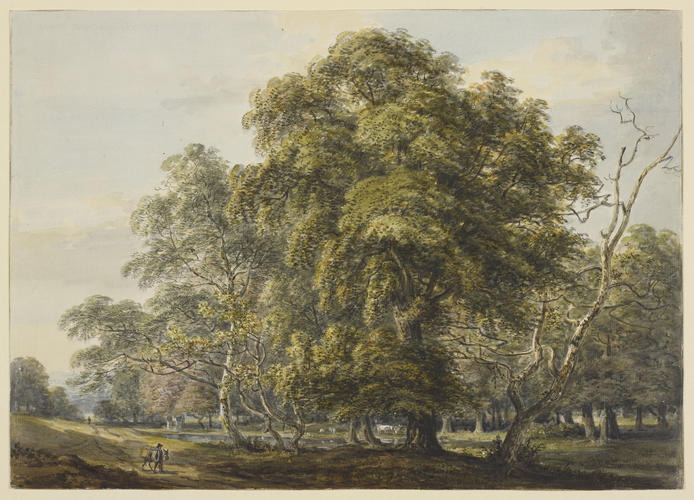Woodland Scene c. 1790
Watercolour and bodycolour | 29.3 x 41.3 cm (sheet of paper) | RCIN 914613
-
A watercolour drawing of a large group of trees. Behind the trees is a pool, with cows grazing, drawn in white bodycolour. Hills in the distance. A man with a pack donkey is in the left foreground. On the far right, a tree stump without leaves. The other trees have full foliage. Inscribed on the verso in pencil, 'In Windsor Park near the Wheelwright's shop, drawn by Paul Sandby'.
The loose, broad treatment can be compared with other watercolour drawings of trees and landscape made by Paul Sandby in the 1790s (for example, RCINs 914619 and 914620). The identification on the verso as Windsor Park may be inaccurate, as it conflicts with the appearance of hills in the background. The Woodyard or Carpenter's Yard was noted on a map of 1750 as immediately to the west of the dairy, very close to Thomas Sandby's house, the Deputy Ranger's Lodge. In the Woodyard, timber was produced for building works, fences and machinery for the Great Park. It was later moved to an area later developed as the Prince Consort's workshops. The drawing is among several that Sandby made of the workshops around the woodyard in Windsor Great Park, many of which are dated 1792. He exhibited two 'Views in the Woodyard, Windsor Great Park' at the Royal Academy in 1793 (nos 541 and 603), one of which is 451587. Other views of the Woodyard in the Royal Collection are 914620, 914618, 917308, 914619 and 914621; five drawings of the woodyard in the British Museum are 1904,0819.110, 1904,0819.97, 1904,0819.120, 1904,0819.59, 1904,0819.24. Others include a watercolour sold at Sotheby's 6 July 2010 (lot 40), a watercolour in the City of Hamilton Art Gallery, Victoria, Australia (inv. no. 1133), a watercolour in Leicestershire Museum and Art Gallery (7a.1904) and a watercolour in the Yale Center for British Art, New Haven (B1975.4.1383).
The woodyard with its carpenters' workshops and wheelwrights' shop was near to the Deputy Ranger's House occupied by Thomas Sandby in Windsor Great Park. The yard was moved to an area further west in the nineteenth century. The reference to the 'Royal Cottage' on the mount is due to the Deputy Ranger's Lodge being redeveloped as the Prince Regent's Cottage in 1813. The yard produced timber for building works across the estate, including fencing and farm machinery. Bruce Robertson has suggested that Sandby made these drawings en plein air during a period of convalescence at his brother's house (The Art of Paul Sandby, exh. cat., New Haven 1985, no. 126). Others (Sotheby's, 6 July 2010, lot 40) have seen these works as evidence of Sandby's affection for the unsung aspects of life on country estates. John Bonehill and Stephen Daniels (Picturing Britain, exh. cat., Nottingham &c 2009, p. 226) have pointed out that Sandby's concentration on the subject of the woodyard coincides with the outbreak of the Napoleonic wars and the felling of large numbers of trees for naval timber; these drawings are thus connected to wider patriotic concerns. In a letter to James Gandon, Sandby wrote that 'the majestic forests of Windsor have long since lowly bowed their heads to the adze of keen necessity, and lust of lucre', with the 'humble elm' lending 'feeble aid to battle with our enemies at sea' (Gandon 1846, p. 184). The development of the Windsor estate in this period was also seen as a sign of the country's benevolent constitution and virtuous sovereign.Provenance
Apparently acquired locally in 1910 under the title 'In Windsor Park near the Wheelwright's shop'.
-
Creator(s)
-
Medium and techniques
Watercolour and bodycolour
Measurements
29.3 x 41.3 cm (sheet of paper)
Object type(s)
Other number(s)
RL 14613Alternative title(s)
In Windsor Park near the Wheelwright's Shop









